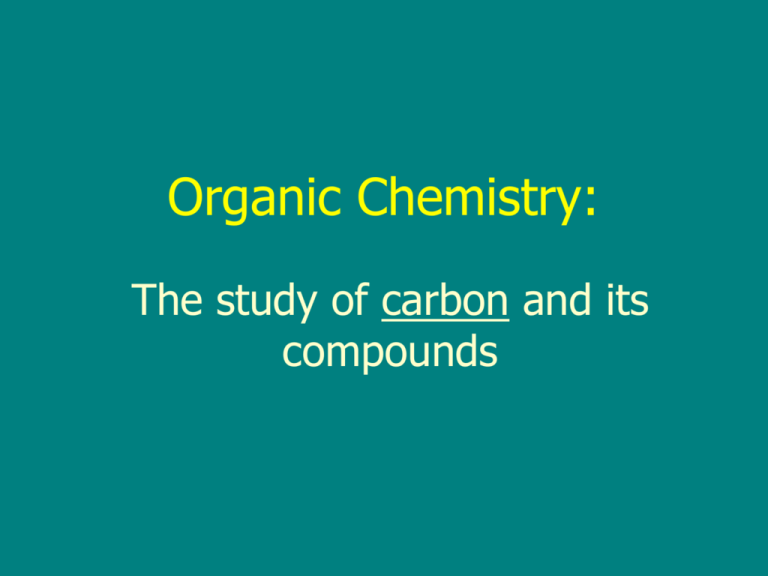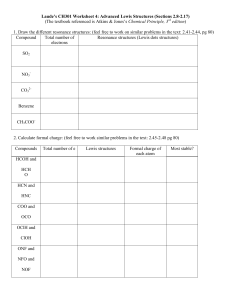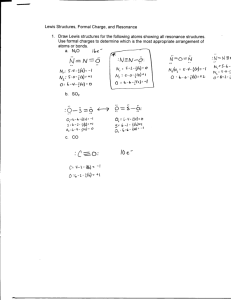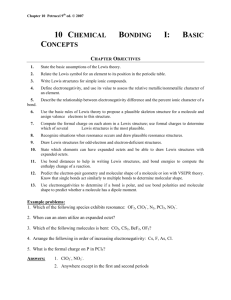This Presentation
advertisement

Organic Chemistry: The study of carbon and its compounds Partial Periodic Table Know these elements! Group IA Period IIA IIIA IVA VA VIA VIIA N O F P S Cl H 1 2 Li Be B 3 Na Mg Al 4 K Ca See the inside back cover of text Si Br Organization of Chemical Compounds Compound Organic Contains C & H, may have N, O, S Covalent bonds Organometallic C covalently bonded to metal, i.e. Mg Inorganic All elements possible Ionic Bonds 1. Bonding: Ionic Bonding—transfer of electrons. So: 1. Bonding (continued): Covalent Bonding—sharing of electrons. H shares H + H H ..H Each two electrons. The simplest way to symbolize the bonding of a covalent molecule is to use Lewis dot structures. In doing so, it is important to remember the octet rule. 1. Bonding (continued): Octet Rule: Atoms will react (i.e. gain, lose or share electrons) in order to have the same number of valence electrons as the nearest noble gas. The sum of all the shared and unshared valence electrons about an atom must total 8. Note that this does not apply to all atoms (e.g. H, B, Al and sometimes S. 1. Bonding (continued) Lewis/Kekule Structures dots = electrons line = two shared electrons all unshared electrons are shown, and are referred to as nonbonding electrons. Each pair of non-bonding electrons is also known as a “lone pair” H H CH3Cl H C Cl H Lewis H C H Kekule Cl 1. Bonding (continued): Note: If you don’t remember how to determine whether or not a Lewis structure has a formal charge, you should review it immediately!!! Multiple bonding in Lewis/Kekule structures: Single Bond: sharing of one electron pair between two atoms. Double Bond: sharing of two electron pairs. Triple Bond: sharing of three electron pairs. 1. Bonding (continued): H H C Lewis H H C C C H H H H Kekule H C H H C C H ethylene O H H C C H C O H acetylene formaldehyde Now, try to do Problems 1-2 and 1-3 on pages 8 and 9 of the text. 1. Bonding (continued): Bonding Patterns # of bonds C N O X 4 3 2 1 H 1 P 3 or 5 S 2, 4 or 6 Structural Formulas: There are two types of structural formulas; complete Lewis structures and condensed formulas. See boxes pages 9 & 13 1. Bonding (continued): Condensed Structural Formulas You must be able to use these by next week Are written without showing all the individual bonds Each central atom is shown together with the atoms bonded to it Multiple bonds are drawn as they would be in a Lewis structure See pages 17-19 1. Bonding (continued): Line-Angle Structural Formulas You must be able to use these by next week Also known as a skeletal structure or a stick figure Bonds are represented by lines Carbon atoms are assumed to be present wherever two lines meet and at the beginning or the end of a line 1. Bonding (continued): Condensed and Line-Angle Formulas H H H H H H H C C C C C C H H H H H H H Kekule CH3CH2CH2CH2CH2CH3 = CH3(CH2)4CH3 = 1 2 3 4 5 6 1 2 3 4 5 6 condensed condensed line-angle You should know how to draw condensed structures from line-angle structures and vice-versa. Do problem 1-10 on page 19 of the text. Review: 1. How many carbons does this compound have? How many hydrogens are at each of the carbons? 2. How many carbons does each of the compounds below have? How many hydrogens are at each of the carbons? 2. Electronegativity Electronegativity refers to the relative tendency of an atom to draw electrons to itself in a chemical bond. Electronegativity increases from left to right and bottom to top across the periodic chart, with F being the most electronegative element. In general, when considering electronegativity, our reference point will be carbon. Electronegativities of the elements Group IA Period 1 IIA IIIA IVA VA VIA VIIA Noble Gases H 2.1 H 2.1 He 2 Li 1.0 Be 1.6 B 1.8 C 2.5 N 3.0 O 3.4 F 4.0 Ne 3 Na 0.9 Mg 1.3 Al 1.6 Si 1.9 P 2.2 S 2.6 Cl 3.2 Ar 4 K 0.8 Ca 1.0 Ga 1.6 Ge 1.8 As 2.0 Se 2.4 Br 3.0 Kr See page 10 2. Electronegativity (continued): D Electronegativity good polarity approximation Know trend & approximate D values C and H these elements are less electronegative than carbon these elements are more electronegative than carbon periodic table 2. Electronegativity (continued): Electronegativity and Bond Polarity A covalent bond with electrons shared equally between the two atoms is called a nonpolar bond. A covalent bond in which the electrons are shared unequally is called a polar bond or a polar covalent bond. H Nonpolar covalent bond H C Cl Polar covalent bond + Na Cl Ionic bond 2. Electronegativity (continued): Polar Covalent Bonds In the carbon—chlorine bond, the electrons are more strongly attracted to Cl than to C because Cl is more electronegative than C. This makes the Cl more ‘negative’, and the C more ‘positive. This is depicted below by the use of a d (delta) symbol. We say that C has a partial positive (d+) charge, and Cl has a partial negative (d-) charge. The bond polarity is symbolized by an arrow with its head at the negative end and a cross at the positive end of the polar bond. Do problem 1-5 on page 11 of the text. d H d Cl Bonds are on a continuum from Ionic to Covalent Carbon almost never forms fully ionic bonds 3. Resonance Recall from your knowledge of general chemistry the concept of formal charges. The formal charge = (group number) - (nonbonding electrons) 1/2(shared electrons). Example: Compute the formal charge at carbon and nitrogen in the species [H2CNH2]+. Step 1: Draw the Lewis H Structure. In doing so, you will see that there C are two possible Lewis structures. H Step 2: Calculate formal charge. H H and N H H C H N H 3. Resonance In the first Lewis structure, the formal charge for C is: FCc = 4 - 0 - 4 = 0. The formal charge for N is: FCN = 5 - 0 - 4 = +1 H H C H N H H + N C H H H In the second Lewis structure, the formal charge for C is : FCc = 4 - 0 - 3 = +1. The formal charge for N is: FCN = 5 - 2 - 3 = 0. H Do problem 1-6 on page 14. H C H H N H C H H N H 3. Resonance When two or more Lewis structures are possible, differing only in the placement of electrons (not atoms), the molecule will show characteristics of both structures. These different structures are called resonance structures or resonance forms. They are not different compounds; they are just different ways of drawing the same compound. Individual resonance forms do not exist. The actual structure of the molecule is a combination of all of its resonance forms, and is said to be a resonance hybrid. In the true structure, the positive charge is spread out over both the C and N atoms. It is said to be delocalized over the C and N atoms. 3. Resonance The interconversion of resonance forms is represented by a double headed arrow. H H + C H N H H C H H resonance forms + N = H H d H H C d+ N H resonance hybrid You can see in the above example that the charge is spread, or delocalized over two atoms: C and N. This makes the ion more stable that in would be if the entire charge were localized on only one atom. Therefore, we call this a resonance-stabilized cation. Resonance promotes stabilization! 3. Resonance Although separate resonance forms do not exist, we can estimate their energies if they did exist. More stable resonance forms are closer representations of the real molecule than less stable ones. The more stable resonance form is called the major contributor, and the less stable resonance form is called the minor contributor. The true structure of the compound resembles the major contributor more than it does the minor contributor. Resonance forms can be compared by the following criteria, beginning with the most important: 1. 2. 3. 4. As many octets as possible. As many bonds as possible. Any negative charges on electronegative atoms. As little charge separation as possible. Based upon these rules, let us determine which is the major resonance contributor in the example that we just did. 3. Resonance Note the curved arrow notation which is used in organic chemistry to show the direction and movement of electrons. Number of octets: Number of bonds: Charge separation?: - Charge on E atoms?: B A H H + C H N H H C H + N H 1 5 No No H 2 6 No No Thus, all things being equal, we can see that structure B is the major resonance contributor, since it has the greater number of octets, and the greater number of bonds. Do problems 1-7 and 1-8 on page 17 of the text. Acidity and Basicity There are three definitions of Acids and Bases: the Arrhenius definition, the Bronsted-Lowry definition, and the Lewis definition. Arrhenius: An acid is a substance that dissociates in water to give H3O+, and a base is a substance that dissociates in water to give OH-. Bronsted-Lowry: An acid is a species that can donate a proton, and a base is a species that can accept a proton. Lewis: An acid is an electron pair acceptor, and a base is an electron pair donor. Let us now consider some examples to see whether we can identify which definitions apply in specific cases. 4. Acidity and Basicity H2SO4 HCl BF3 + + + H2O HSO4 NaOH NaCl NH3 + H3N + H3O H2O BF3 We can see from these examples that the Arrhenius and Bronsted-Lowry definitions of acids and bases fail in some instances in allowing us to identify which species is an acid and which is a base. The Lewis definition is the only one that will allow us to make the correct predictions all the time. Do not forget that when an acid reacts it forms a conjugate base, and when a base reacts if forms a conjugate acid! 4. Acidity and Basicity The strength of both Bronsted-Lowry and Arrhenius acids is expressed by the extent of their ionization in water. The general reaction of an acid (HA) with water is as follows: HA + H2O Ka H3O + A where Ka represents the acid-dissociation constant. + - [H3O ][A ] Ka = [HA] The magnitude of Ka represents the relative strength of the acid. The stronger the acid, the more it dissociates, giving a larger Ka. 4. Acidity and Basicity Strong Acids: Are almost completely ionized in water; Have Ka’s greater than 1. Weak Acids: (most organic compounds); have Ka’s less than 10-4. Ka’s are often expressed on a logarithmic scale: pKa = -log10Ka For water: H2O and + H2O OH + H3O - -14 [H3O ][OH ] -16 1.00 x 10 Ka = = = 1.8 x 10 [H2O] 55.6 mol/L + The logarithm of 1.8 x 10-16 is -15.7, and the pKa of water is 15.7 See page 24 of the text. 4. Acidity/Basicity Table 1-5 on page 25 of the text lists some common organic and inorganic acids and their conjugate bases. From this table, you can see that: 1. 2. 3. 4. Strong acids generally have pKa values of ~ 0. Weak acids generally have pka values of > 4. The weaker the acid, the larger the pKa. The weaker the acid, the smaller the Ka. Predicting the direction of Acid/Base Equilibria: In order to predict the direction of acid/base equilibria, it is important to remember the following: 1. Acid base reactions favor formation of the weaker acid and the weaker base. 2. The stronger the acid, the weaker its conjugate base. 3. The weaker the acid, the stronger its conjugate base. 4. Acidity/Basicity Examples: HCl + H2O strong acid CH3-OH weak acid - Cl + + H3O weak base + H2O - CH3O + strong base Do problems 1-14, 1-15 and 1-16 on page 26 and 28 of the text.. + H3O 4. Acidity/Basicity Predicting Acidity Generally speaking, the more stable a conjugate base is, the more acidic the acid from which it came. There are three factors that affect the stability of conjugate bases. These are electronegativity, size, and resonance. Electronegativity: The more electronegative an element is, the more easily it bears a negative charge, giving a more stable conjugate base, and a stronger acid. 4. Acidity/Basicity Electronegativity C < N < O < F electronegativity increases Stability Acidity - CH3 < H-CH3 < - NH2 < H-NH2 < - OH < H-OH < - F H-F acidity increases Basicity - CH3 > - NH2 > - OH basicity increases See page 29 of the text. > - F 4. Acidity/Basicity Size: The negative charge of an anion is more stable if is spread over a large region of space. Within a column of the periodic table, acidity increases down the column, as the size of the elements increases. H-F < Acidity Stability H-Cl < H-Br < H-I < I acidity increases - F < - Cl < Br size increases - - 4. Acidity/Basicity Resonance Stabilization: A conjugate base of an acid is more likely to form if it can be stabilized by resonance. See bottom of page 29 in the text. CH3CH2 O ethoxide ion from ethanol (pKa = 16) O H3C C O O H3C C O acetate ion from acetic acid (pKa = 4.74) O O H3C S O O H3C S O O O H3C S O O methanesulfonate ion from methanesulfonic acid (pKa = -1.2) 4. Acidity/Basicity One Final Note: Non proton Lewis acids are known as Electrophiles. Lewis Bases are known as Nucleophiles. Most of the acid/base chemistry that we will encounter in this course will be described in terms of nucleophiles and electrophiles. It is very very important that you be thoroughly familiar with these two terms. Common Symbols & Abbreviations ,e &e Electron Radical Cation Pair of Electrons Radical Anion Cation Bonds Anion More abbreviations D = difference d = partial (d+, d-) = polar bond, in direction of electron polarization





